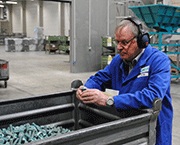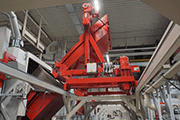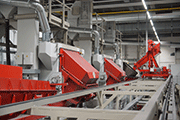E-Archive
Articles
in Vol. 20 - November Issue - Year 2019
Optimum Blasting Of Fastening Elements

Johan de Hek, Plant Manager at Benseler Oberflächentechnik (Lüdenscheid Plant), checks workpieces prior to shipping

Loading an AGTOS drum-type blasting machine with workpieces (fastening elements)

Three AGTOS drum-type blasting machines in an automated process
For more than 50 years, the BENSELER Group has been a competent partner for technically sophisticated solutions in the areas of coating, surface finishing, deburring and design of series components. 2017 saw the commissioning of a new plant in Lüdenscheid – prominently located right next to the A 45. In addition to its award-winning architecture, this aesthetically appealing structure embodies a multitude of modern technical details that are especially attractive.
Particular attention was paid to energy efficiency. This is reflected in heat exchangers installed on the ovens and an in-house thermal circuit for the pretreatment process and the building. In addition, a chiller operated with waste heat ensures that room temperatures are pleasant at all times.
It therefore comes as no surprise to see that new approaches have also been adopted in surface technology with the creation of a fully automated concept.
Benseler has introduced job coating of fastening elements for customer orders at the Lüdenscheid location. As a consequence, screws, nuts and washers all receive a high-quality zinc flake coating through the GEOMET® process. In total, 2,500 to 5,000 different parts and designs are involved.
The majority of customers are in the automotive supplier industry, and they insist on workpieces retaining absolutely identical characteristics after processing. This stipulation also influences surface coating.
Pretreatment of workpieces is realised in three drum-type blasting machines installed on the line by AGTOS. These are filled automatically and emptied onto a conveyor belt that transports the parts to the coating process.
Johan Adriaan de Hek, Plant Manager at Lüdenscheid: "We opted in favour of AGTOS as a supplier for blasting technology, as we were impressed by the drum-type blasting system concept. It’s similar to the concept of the downstream coating process." Drum-type blasting systems have the major advantage of eliminating any tilting or jamming of parts. Damage to parts is prevented as a result, and this is also an absolute necessity during mass production in the automotive industry. A further advantage of these machines is their low-maintenance requirement, this being a consequence of the avoidance of jamming. The geometry of the drums means they can be emptied completely, thus preventing mixing of different workpieces.
Over the years, Benseler has gained extensive experience of different blasting technology concepts. One example was the use of a large snail drum blasting system, but the extensive drop height involved here during charging led to damage of the workpieces. Other machines of the same type exhibited disadvantages during emptying, and rubber belt blasting systems also proved inadequate.
The concept presently employed, which involves a combination of three smaller AGTOS drum-type blasting machines, ensures that the company has adequate reserves to increase capacities even further in future. Blasting of around 150 t per day is currently realised with a cycle time of approximately 6 minutes per blasting machine. The loading capacity of the machines is approximately 250 kg, depending on the geometry of the workpieces. The parts are introduced gently to the drums and discharged with equal care following blasting by tilting the drums.
A centralised control system was installed at Benseler that monitors the complete coating line. A plug-in control panel enables direct on-site operation of individual machines. Electric linking not only involves the master computer, which manages and visualises machine data, but the blasting machines were linked to the production line by WMV Apparatebau GmbH, meaning that charging/discharging and the blasting machines work hand-in-hand and some functions can operated parallel to each other, thus preventing time wastage as well. This means that all players involved on the production line are optimally integrated.
Key advantages of AGTOS drum-type blasting machines
Drum-type blasting machines are filled in batches using automated charging equipment. The drum is in the loading position for this purpose, pivoting into the blasting position after the charging process. An AGTOS high-performance turbine hurls abrasive into the rotating drum. Effective mixing means that all workpieces are exposed to the same degree of blasting. Following blasting, they are gently tipped out of the drum back into the original container, or conveyed on further, on a belt.
What is special about this system is the attention to detail. First and foremost, it is necessary to work out what the customer requires from the blasting process. Machine requirements are derived from this, namely the geometry of the drum base, the perforation of the drum which allows the abrasive to flow off and the degree of mixing of the parts. This part of the project involves a mutual exchange of experience between the customer and manufacturer.
The combination of several machines makes the development of a continuous production system possible. In addition to an increase in capacity achieved through additional machines, this concept reduces non-productive periods and compensates for downtimes (e.g. due to maintenance).
Proven processes are essential for reliable production. AGTOS high-performance turbines employing the practical single-disc system are a further maintenance-friendly and powerful argument in favour of this plant. Optimised design saves abrasive, the real tool of blasting technology. In addition to these proven turbines, the reliable and service-friendly filter technology employed also deserves particular mention. Cleaning of filter cartridges governed by differential pressure also contributes to efficient operation.
A further aspect of the design process relating to these drum-type blasting machines was energy efficiency. All drives are designed to conform to the current Ecodesign Directive. As a consequence, the blasting machine consumes a comparatively low volume of energy when compared to conventional systems, and this keeps operating costs down.
The extent of the blasting plant needed is developed on the basis of customer requirements and experience. Numerous variables, such as turbine performance, the charging and discharging system, abrasive type or other influencing factors ensure that the customer receives an extremely individual system.
The abrasive is maintained in continuous circulation. This involves collection following the blasting process and its conveyance to the upper part of the machine using a bucket elevator. The abrasive is cleaned here and undersized particles are eliminated before it is fed back again to the high-performance turbines.
For Information:
AGTOS GmbH
Gutenbergstrasse 14
48282 Emsdetten, Germany
Tel. +49.2572.96026-0
Fax +49.2572.96026-111
E-mail: info@agtos.de
www.agtos.de



























